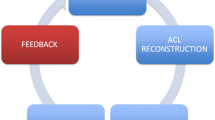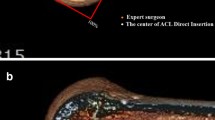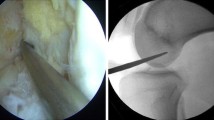Abstract
Purpose
To evaluate the effect of feedback from post-operative 3D CT in the learning process of placing the femoral graft tunnel anatomically using the anteromedial (AM)-portal technique in single-bundle anterior cruciate ligament (ACL) reconstruction.
Methods
An experienced knee surgeon converting from transtibial to AM-portal technique was offered post-operative feedback on tunnel placement. Three groups of patients were included: transtibial drilling, (AM1) anteromedial drilling without feedback and (AM2) anteromedial drilling with post-operative CT feedback. Intra-articular landmarks were used as the only guidance for tunnel placement. Tunnel position was compared to an ideal anatomical ACL position using the Bernard and Hertel grid and visual feedback was given on tunnel placements. The effect of feedback was measured as the distance from the anatomical centre, and spread of tunnel placements on post-operative CT performed feedback was initiated.
Results
When comparing the femoral tunnel placement to an ideal anatomical centre, there was an improvement in the mean tunnel position after (A) changing from a transtibial to an anatomical technique and a further improvement after (B) initializing the radiological feedback. There was a great variation of femoral tunnel localizations when initially only using intra-articular landmarks as guidance for tunnel placement—this variation, however, converged towards the anatomical centre throughout the feedback period and the AM2 group had a femoral tunnel closer (P = 0.001) to the anatomical centre than the AM1 group.
Conclusions
Post-operative 3D CT is effective in the learning process of placing femoral tunnels anatomically by giving post-operative feedback on tunnel placement. Bony landmarks and ACL remnants were found unreliable as the only guidance for femoral tunnel placement in the AM-portal technique—therefore, the use of an aid is recommended to reduce unwanted tunnel variations in a learning phase.
Level of evidence
Cohort Study, Level III.



Similar content being viewed by others
References
Aglietti P, Buzzi R, Giron F, Simeone AJ, Zaccherotti G (1997) Arthroscopic-assisted anterior cruciate ligament reconstruction with the central third patellar tendon. A 5–8-year follow-up. Knee Surg Sports Traumatol Arthrosc 5:138–144
Ahlden M, Sernert N, Karlsson J, Kartus J (2013) A prospective randomized study comparing double- and single-bundle techniques for anterior cruciate ligament reconstruction. Am J Sports Med 41:2484–2491
Bedi A, Maak T, Musahl V, Citak M, O’Loughlin PF, Choi D, Pearle AD (2011) Effect of tibial tunnel position on stability of the knee after anterior cruciate ligament reconstruction: is the tibial tunnel position most important? Arthroscopy 27:1543–1551
Bedi A, Musahl V, Steuber V, Kendoff D, Choi D, Allen AA, Pearle AD, Altchek DW (2011) Transtibial versus anteromedial portal reaming in anterior cruciate ligament reconstruction: an anatomic and biomechanical evaluation of surgical technique. Arthroscopy 27:380–390
Bernard M, Hertel P, Hornung H, Cierpinski T (1997) Femoral insertion of the ACL. Radiographic quadrant method. Am J Knee Surg 10:14–21
Bird JH, Carmont MR, Dhillon M, Smith N, Brown C, Thompson P, Spalding T (2011) Validation of a new technique to determine midbundle femoral tunnel position in anterior cruciate ligament reconstruction using 3-dimensional computed tomography analysis. Arthroscopy 27:1259–1267
Brown CH, Sklar JH (2006) Endoscopic anterior cruciate ligament reconstruction using quadrupled hamstring tendons and endobutton femoral fixation. Tech Orthop 13:281–298
Brown CH, Spalding T, Robb C (2013) Medial portal technique for single-bundle anatomical anterior cruciate ligament (ACL) reconstruction. Int Orthop 37:253–269
Farrow LD (2007) Morphology of the femoral intercondylar notch. J Bone Joint Surg Am 89:2150
Ferretti M, Ekdahl M, Shen W, Fu FH (2007) Osseous landmarks of the femoral attachment of the anterior cruciate ligament: an anatomic study. Arthroscopy 23:1218–1225
Ferretti A, Monaco E, Giannetti S, Caperna L, Luzon D, Conteduca F (2010) A medium to long-term follow-up of ACL reconstruction using double gracilis and semitendinosus grafts. Knee Surg Sports Traumatol Arthrosc 19:473–478
Forsythe B (2010) The location of femoral and tibial tunnels in anatomic double-bundle anterior cruciate ligament reconstruction analyzed by three-dimensional computed tomography models. J Bone Joint Surg Am 92:1418–1426
Fu FH (2007) The lateral intercondylar ridge—a key to anatomic anterior cruciate ligament reconstruction. J Bone Joint Surg Am 89:2103–2104
Heming JF, Rand J, Steiner ME (2007) Anatomical limitations of transtibial drilling in anterior cruciate ligament reconstruction. Am J Sports Med 35:1708–1715
Horie M, Muneta T, Yamazaki J, Nakamura T, Koga H, Watanabe T, Sekiya I (2013) A modified quadrant method for describing the femoral tunnel aperture positions in ACL reconstruction using two-view plain radiographs. Knee Surg Sports Traumatol Arthrosc. doi:10.1007/s00167-013-2781-8
Hussein M, van Eck CF, Cretnik A, Dinevski D, Fu FH (2012) Prospective randomized clinical evaluation of conventional single-bundle, anatomic single-bundle, and anatomic double-bundle anterior cruciate ligament reconstruction: 281 cases with 3- to 5-year follow-up. Am J Sports Med 40:512–520
Iriuchishima T, Horaguchi T, Kubomura T, Morimoto Y, Fu FH (2011) Evaluation of the intercondylar roof impingement after anatomical double-bundle anterior cruciate ligament reconstruction using 3D-CT. Knee Surg Sports Traumatol Arthrosc 19:674–679
Kasten P, Szczodry M, Irrgang J, Kropf E, Costello J, Fu FH (2010) What is the role of intra-operative fluoroscopic measurements to determine tibial tunnel placement in anatomical anterior cruciate ligament reconstruction? Knee Surg Sports Traumatol Arthrosc 18:1169–1175
Khalfayan EE, Sharkey PF, Alexander AH, Bruckner JD, Bynum EB (1996) The relationship between tunnel placement and clinical results after anterior cruciate ligament reconstruction. Am J Sports Med 24:335–341
Kim HS, Seon JK, Jo AR (2013) Current trends in anterior cruciate ligament reconstruction. Knee Surg Relat Res 25:165
Larson AI, Bullock DP, Pevny T (2012) Comparison of 4 femoral tunnel drilling techniques in anterior cruciate ligament reconstruction. Arthroscopy 28:972–979
Lee YS, Sim JA, Kwak JH, Nam SW, Kim KH, Lee BK (2012) Comparative analysis of femoral tunnels between outside-in and transtibial double-bundle anterior cruciate ligament reconstruction: a 3-dimensional computed tomography study. Arthroscopy 28:1417–1423
Middleton KK, Hamilton T, Irrgang JJ, Karlsson J, Harner CD, Fu FH (2014) Anatomic anterior cruciate ligament (ACL) reconstruction: a global perspective. Part 1. Knee Surg Sports Traumatol Arthrosc. doi:10.1007/s00167-014-2846-3
Musahl V (2005) Varying femoral tunnels between the anatomical footprint and isometric positions: effect on kinematics of the anterior cruciate ligament-reconstructed knee. Am J Sports Med 33:712–718
Pinczewski LA, Salmon LJ, Jackson WFM, von Bormann RBP, Haslam PG, Tashiro S (2008) Radiological landmarks for placement of the tunnels in single-bundle reconstruction of the anterior cruciate ligament. J Bone Joint Surg Br 90:172–179
Rahr-Wagner L, Thillemann TM, Pedersen AB, Lind MC (2013) Increased risk of revision after anteromedial compared with transtibial drilling of the femoral tunnel during primary anterior cruciate ligament reconstruction: results from the Danish Knee Ligament Reconstruction Register. Arthroscopy 29:98–105
Siegel L, Vandenakker-Albanese C, Siegel D (2012) Anterior cruciate ligament injuries: anatomy, physiology, biomechanics, and management. Clin J Sport Med 22:349–355
Snow M, Standish WD (2012) Double-bundle ACL reconstruction: how big is the learning curve? Knee Surg Sports Traumatol Arthrosc 18:1195–1200
Taketomi S, Inui H, Nakamura K, Hirota J, Takei S, Takeda H, Tanaka S, Nakagawa T (2012) Three-dimensional fluoroscopic navigation guidance for femoral tunnel creation in revision anterior cruciate ligament reconstruction. Arthrosc Tech 1:95–99
Taketomi S, Inui H, Nakamura K, Hirota J, Sanada T, Masuda H, Takeda H, Tanaka S, Nakagawa T (2013) Clinical outcome of anatomic double-bundle ACL reconstruction and 3D CT model-based validation of femoral socket aperture position. Knee Surg Sports Traumatol Arthrosc. doi:10.1007/s00167-013-2663-0
Tensho K, Shimodaira H, Aoki T, Narita N, Kato H, Kakegawa A, Fukushima N, Moriizumi T, Fujii M, Fujinaga Y, Saito N (2014) Bony landmarks of the anterior cruciate ligament tibial footprint: a detailed analysis comparing 3-dimensional computer tomography images to visual and histological analyses. Am J Sports Med 42:1433–1440
Tompkins M, Milewski MD, Brockmeier SF, Gaskin CM, Hart JM, Miller MD (2012) Anatomic femoral tunnel drilling in anterior cruciate ligament reconstruction: use of an accessory medial portal versus traditional transtibial drilling. Am J Sports Med 40:1313–1321
Tsukada S, Fujishiro H, Watanabe K, Nimura A, Mochizuki T, Mahakkanukrauh P, Yasuda K, Akita K (2014) Anatomic variations of the lateral intercondylar ridge: relationship to the anterior margin of the anterior cruciate ligament. Am J Sports Med. doi:10.1177/0363546514524527
van Eck CF, Martins CAQ, Vyas SM, Celentano U, van Dijk CN, Fu FH (2010) Femoral intercondylar notch shape and dimensions in ACL-injured patients. Knee Surg Sports Traumatol Arthrosc 18:1257–1262
Watanabe S, Satoh T, Sobue T, Koga Y, Oomori G, Nemoto A, Watanabe Y, Shimura M (2005) Three-dimentional evaluation of femoral tunnel position in anterior cruciate ligament reconstruction. Hiza (J Jpn Knee Soc) 30:253–256
Westermann R, Sybrowsky C, Ramme A, Amedola A, Wolf B (2014) Three-dimensional characterization of the anterior cruciate ligament’s femoral footprint. J Knee Surg 27:53–58
Wolf BR, Ramme AJ, Wright RW, Brophy RH, McCarty EC, Vidal AR, Parker RD, Andrish JT, Amendola A, Moon Knee Group, Grosland NM, Britton CL, Dunn WR, Spindler KP, Cox CL, Carey JL, Kaeding CC, Flanigan DC, Matava MJ, Smith MV, Marx RG, Jones MH (2013) Variability in ACL tunnel placement: observational clinical study of surgeon ACL tunnel variability. Am J Sports Med 41:1265–1273
Yagi M, Wong EK, Kanamori A, Debski RE, Fu FH, Woo SL-Y (2002) Biomechanical analysis of an anatomic anterior cruciate ligament reconstruction. Am J Sports Med 30:660–666
Yang JH, Chang M, Kwak DS, Jang KM, Wang JH (2014) In vivo three-dimensional imaging analysis of femoral and tibial tunnel locations in single and double-bundle anterior cruciate ligament reconstructions. Clin Orthop Surg. doi:10.4055/cios.2014.6.1.32
Youm Y-S, Cho S-D, Eo J, Lee K-J, Jung K-H, Cha J-R (2013) 3D CT analysis of femoral and tibial tunnel positions after modified transtibial single bundle ACL reconstruction with varus and internal rotation of the tibia. Knee 20:272–276
Conflict of interest
No conflict of interest reported from any of the authors.
Author information
Authors and Affiliations
Corresponding author
Rights and permissions
About this article
Cite this article
Inderhaug, E., Larsen, A., Strand, T. et al. The effect of feedback from post-operative 3D CT on placement of femoral tunnels in single-bundle anatomic ACL reconstruction. Knee Surg Sports Traumatol Arthrosc 24, 154–160 (2016). https://doi.org/10.1007/s00167-014-3355-0
Received:
Accepted:
Published:
Issue Date:
DOI: https://doi.org/10.1007/s00167-014-3355-0




